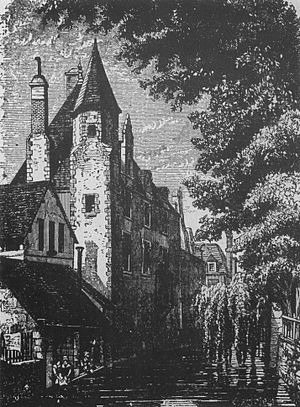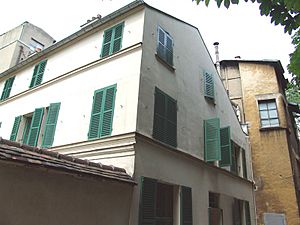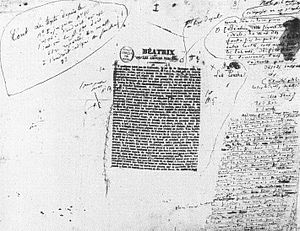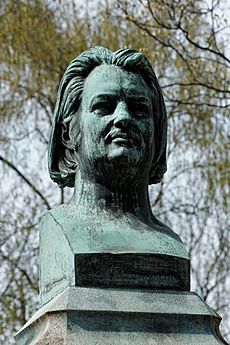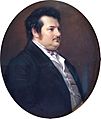Honoré de Balzac facts for kids
Quick facts for kids
Honoré de Balzac
|
|
|---|---|

Honoré de Balzac on an 1842 daguerreotype
by Louis-Auguste Bisson |
|
| Born | 20 May 1799 |
| Died | 18 August 1850 (age 51) Paris, France
|
| Occupation | Novelist, playwright |
| Spouse(s) | Ewelina Hańska |
Honoré de Balzac ( 20 May 1799 – 18 August 1850) was a French novelist and playwright. His most famous work is La Comédie humaine. It is a collection of novels and short stories and is about French life after 1815. La Peau de chagrin (1831), Eugénie Grandet (1833) and Le Père Goriot (1835) are some of the most famous works from this collection. His books influenced many other people such as Marcel Proust, Émile Zola, Gustave Flaubert, Charles Dickens and Edgar Allan Poe.
Contents
Biography
Family
Honoré de Balzac was born into a family which aspired to achieve respectability through its industry and efforts. His father, born Bernard-François Balssa, was one of eleven children from an artisan family in Tarn, a region in the south of France. In 1760 he set off for Paris with only a Louis coin in his pocket, intent on improving his social standing; by 1776 he had become Secretary to the King's Council and a Freemason (he had also changed his name to the more noble sounding "Balzac", his son later adding—without official recognition—the nobiliary particle: "de"). After the Reign of Terror (1793–94), François Balzac was despatched to Tours to coordinate supplies for the Army.
Balzac's mother, born Anne-Charlotte-Laure Sallambier, came from a family of haberdashers in Paris. Her family's wealth was a considerable factor in the match: she was eighteen at the time of the wedding, and François Balzac fifty. As the author and literary critic Sir Victor Pritchett explained, "She was certainly drily aware that she had been given to an old husband as a reward for his professional services to a friend of her family and that the capital was on her side. She was not in love with her husband".
Honoré (named after Saint-Honoré of Amiens, who is commemorated on 16 May, four days before Balzac's birthday) was actually the second child born to the Balzacs; exactly one year earlier, Louis-Daniel had been born, but he lived for only a month. Honoré's sisters Laure and Laurence were born in 1800 and 1802, and his younger brother Henry-François in 1807.
Early life
As an infant Balzac was sent to a wet nurse; the following year he was joined by his sister Laure and they spent four years away from home. Sending babies to wet nurses was common among the middle and upper classes. When the Balzac children returned home, they were kept at a frosty distance from their parents, which affected the author-to-be significantly. His 1835 novel Le Lys dans la vallée features a cruel governess named Miss Caroline, modeled after his own caregiver.
At age ten Balzac was sent to the Oratorian grammar school in Vendôme, where he studied for seven years. His father, seeking to instill the same hardscrabble work ethic which had gained him the esteem of society, intentionally gave little spending money to the boy. This made him the object of ridicule among his much wealthier schoolmates.
Balzac had difficulty adapting to the rote style of learning at the school. As a result, he was frequently sent to the "alcove", a punishment cell reserved for disobedient students. (The janitor at the school, when asked later if he remembered Honoré, replied: "Remember M. Balzac? I should think I do! I had the honour of escorting him to the dungeon more than a hundred times!") Still, his time alone gave the boy ample freedom to read every book which came his way.
Balzac worked these scenes from his boyhood—as he did many aspects of his life and the lives of those around him—into La Comédie humaine. His time at Vendôme is reflected in Louis Lambert, his 1832 novel about a young boy studying at an Oratorian grammar school at Vendôme. The narrator says : "He devoured books of every kind, feeding indiscriminately on religious works, history and literature, philosophy and physics. He had told me that he found indescribable delight in reading dictionaries for lack of other books."
Balzac often fell ill, finally causing the headmaster to contact his family with news of a "sort of a coma". When he returned home, his grandmother said: "Voilà donc comme le collège nous renvoie les jolis que nous lui envoyons!" ("Look how the academy returns the pretty ones we send them!") Balzac himself attributed his condition to "intellectual congestion", but his extended confinement in the "alcove" was surely a factor.
In 1814 the Balzac family moved to Paris, and Honoré was sent to private tutors and schools for the next two and a half years. This was an unhappy time in his life.
In 1816 Balzac entered the Sorbonne, where he studied under three famous professors: François Guizot, who later became Prime Minister, was Professor of Modern History; Abel-François Villemain, a recent arrival from the Collège Charlemagne, lectured on French and classical literature; and, most influential of all, Victor Cousin's courses on philosophy encouraged his students to think independently.
Once his studies were completed, Balzac was persuaded by his father to follow him into the Law; for three years he trained and worked at the office of Victor Passez, a family friend.
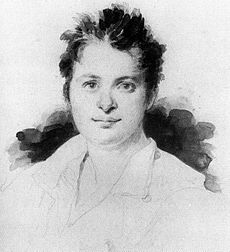
In 1819 Passez offered to make Balzac his successor, but his apprentice had had enough of the Law. He despaired of being "a clerk, a machine, a riding-school hack, eating and drinking and sleeping at fixed hours. I should be like everyone else. And that's what they call living, that life at the grindstone, doing the same thing over and over again.... I am hungry and nothing is offered to appease my appetite". He announced his intention to become a writer.
The loss of this opportunity caused serious discord in the Balzac household, although Honoré was not turned away entirely. Instead, in April 1819 he was allowed to live in the French capital—as English critic George Saintsbury describes it—"in a garret furnished in the most Spartan fashion, with a starvation allowance and an old woman to look after him", while the rest of the family moved to a house twenty miles [32 km] outside Paris.
First literary efforts
Balzac's first project was a libretto for a comic opera called Le Corsaire, based on Lord Byron's The Corsair. Realizing he would have trouble finding a composer, however, he turned to other pursuits.
In 1820 Balzac completed the five-act verse tragedy Cromwell. Although it pales by comparison with his later works, some critics consider it a good-quality text. When he finished, Balzac went to Villeparisis and read the entire work to his family; they were unimpressed. He followed this effort by starting (but never finishing) three novels: Sténie, Falthurne, and Corsino.
In 1821 Balzac met the enterprising Auguste Le Poitevin, who convinced the author to write short stories, which Le Poitevin would then sell to publishers. Balzac quickly turned to longer works, and by 1826 he had written nine novels, all published under pseudonyms and often produced in collaboration with other writers.
La Comédie Humaine and literary success
After writing several novels, in 1832 Balzac conceived the idea for a series of books that would paint a panoramic portrait of "all aspects of society". The moment the idea came to him, Balzac raced to his sister's apartment and proclaimed: "I am about to become a genius!" It eventually became known as La Comédie Humaine, and he included in it all the fiction that he had published in his lifetime under his own name. This was to be Balzac's life work and his greatest achievement.
Les Chouans (1829) was the first book Balzac released under his own name. It established him as an author of note and provided him with a name outside his past pseudonyms.
El Verdugo was the first work signed "Honoré de Balzac". He followed his father in the surname Balzac but added the aristocratic-sounding nobiliary particle to help him fit into respected society, a choice based on skill rather than by right.

1831 saw the success of La Peau de chagrin, a fable-like tale about a despondent young man named Raphaël de Valentin who finds an animal skin which promises great power and wealth. He obtains these things, but loses the ability to manage them. In the end, his health fails and he is consumed by his own confusion. Balzac meant the story to bear witness to the treacherous turns of life, its "serpentine motion".
In 1833 Balzac released Eugénie Grandet, his first best-seller. The tale of a young lady who inherits her father's miserliness, it also became the most critically acclaimed book of his career. It is followed by La Duchesse de Langeais, arguably the most sublime of his novels.
Le Père Goriot (Old Father Goriot, 1835) was his next success. In 1836 Balzac took the helm of the Chronique de Paris, a weekly magazine of society and politics. It produced three issues.
Le Cousin Pons (1847) and La Cousine Bette (1848) tell the story of Les Parents Pauvres (The Poor Relations). The conniving and wrangling over wills and inheritances reflect the expertise gained by the author as a young law clerk. Balzac's health was deteriorating by this point, making the completion of this pair of books a significant accomplishment.
Many of his novels were initially serialized, like those of Dickens. Their length was not predetermined. Illusions Perdues extends to a thousand pages after starting inauspiciously in a small-town print shop, whereas La Fille aux yeux d'or (The Girl with the Golden Eyes, 1835) opens with a broad panorama of Paris but becomes a closely plotted novella of only fifty pages.
Work habits
Balzac's work habits were legendary. He wrote from 1 am to 8 am every morning and sometimes even longer. Balzac could write very rapidly; some of his novels, written with a quill, were composed at a pace equal to thirty words per minute on a modern typewriter. His preferred method was to eat a light meal at five or six in the afternoon, then sleep until midnight. He then rose and wrote for many hours, fueled by innumerable cups of black coffee. He often worked for fifteen hours or more at a stretch; he claimed to have once worked for 48 hours with only three hours of rest in the middle.
Balzac revised obsessively, covering printer's proofs with changes and additions to be reset. He sometimes repeated this process during the publication of a book, causing significant expense both for himself and the publisher. As a result, the finished product quite often was different from the original text. Although some of his books never reached completion, some—such as Les employés (The Government Clerks, 1841)—are nonetheless noted by critics.
Although Balzac was "by turns a hermit and a vagrant", he managed to stay in tune with the social spheres which nourished his writing. He was friends with Théophile Gautier and Pierre-Marie-Charles de Bernard du Grail de la Villette, and he was acquainted with Victor Hugo. Nevertheless, he did not spend as much time in salons and clubs of Paris like many of his characters. "In the first place he was too busy", explains Saintsbury, "in the second he would not have been at home there.... [H]e felt it was his business not to frequent society but to create it". However he often spent long periods at the Château de Saché, near Tours, the home of his friend Jean de Margonne, his mother's lover and father to her youngest child. Many of Balzac's tormented characters were conceived in the chateau's small second-floor bedroom. Today the chateau is a museum dedicated to the author's life.
Marriage, romantic relationships, and death
In February 1832 Balzac received an intriguing letter from Odessa—with no return address and signed simply "L'Étrangère" ("The Foreigner")—expressing sadness at the cynicism and atheism in La Peau de Chagrin and its negative portrayal of women. His response was to place a classified advertisement in the Gazette de France, hoping that his anonymous critic would see it. Thus began a fifteen-year correspondence between Balzac and "the object of [his] sweetest dreams": Ewelina Hańska.


Ewelina (née Rzewuska) was married to a nobleman twenty years her senior, Marshal Wacław Hański, a wealthy Polish landowner living near Kyiv. It had been a marriage of convenience to preserve her family's fortune. In Balzac Countess Ewelina found a kindred spirit.
Marshal Hański died in 1841, and his widow and her admirer finally had the chance to pursue their affections. Balzac visited Countess Hańska in St. Petersburg in 1843 and won her heart. After a series of financial setbacks, health problems and objections from Tsar Nicholas I, the couple finally received permission to wed. On 14 March 1850, with Balzac's health in serious decline, they travelled by carriage from her family seat at Verhivnya Park in Volhynia to St. Barbara's Catholic Church in Berdychiv (Russia's former banking city in present-day Ukraine), where they were married by Abbot Ożarowski. The ten-hour journey to and from the ceremony took a toll on both husband and wife: her feet were too swollen to walk, and he endured severe heart trouble.
Although he married late in life, Balzac had already written two treatises on marriage: Physiologie du Mariage and Scènes de la Vie Conjugale. These works lacked firsthand knowledge; Saintsbury points out that "cœlebs cannot talk of [marriage] with much authority". In late April the newly-weds set off for Paris. His health deteriorated on the way, and Ewelina wrote to her daughter about Balzac being "in a state of extreme weakness" and "sweating profusely". They arrived in the French capital on 20 May, his fifty-first birthday.
Five months after his wedding, on Sunday, 18 August 1850, Balzac died in the presence of his mother — his wife, Eve de Balzac (formerly Countess Hańska) had gone to bed. He had been visited that day by Victor Hugo, who later served as a pallbearer and the eulogist at Balzac's funeral.
Balzac is buried at Père Lachaise Cemetery in Paris. At his memorial service, Victor Hugo pronounced "Today we have people in black because of the death of the man of talent; a nation in mourning for a man of genius". The funeral was attended by "almost every writer in Paris", including Frédérick Lemaître, Gustave Courbet, Dumas père and Dumas fils, as well as representatives of the Légion d'honneur and other dignitaries.
Later, a statue (called the Monument to Balzac) was created by the celebrated French sculptor Auguste Rodin. Cast in bronze, the Balzac Monument has stood since 1939 nearby the intersection of Boulevard Raspail and Boulevard Montparnasse at Place Pablo-Picasso. Rodin featured Balzac in several of his smaller sculptures as well.
Works
Novels
- Les Chouans (1829)
- La Maison du chat-qui-pelote (1829)
- La Vendetta (1830)
- La Peau de chagrin (1831)
- Les Proscrits (1831)
- Louis Lambert (1832)
- Eugénie Grandet (1833)
- Le Médecin de campagne (1833)
- Ferragus, chef des Dévorants (1833)
- La Duchesse de Langeais (1834)
- La Recherche de l'absolu (1834)
- Séraphîta (1834)
- Le Père Goriot (1835)
- Le Lys dans la vallée (1835)
- Le Contrat de mariage (1835)
- La Vieille Fille (1836)
- César Birotteau (1837)
- Le Cabinet des Antiques (1838)
- Une fille d'Ève (1838)
- Béatrix (1839)
- Le Curé de village (1839)
- Un grand homme de province à Paris (1839)
- Ursule Mirouët (1841)
- Une ténébreuse affaire (1841)
- Mémoires de deux jeunes mariées (1841)
- La Fausse Maîtresse (1841)
- La Femme de trente ans (1829–1842)
- Albert Savarus (1842)
- La Rabouilleuse (1842)
- Un début dans la vie (1842)
- Illusions perdues (1837-1843)
- Honorine (1843)
- Modeste Mignon (1844)
- La Cousine Bette (1846)
- Splendeurs et misères des courtisanes (1838–1847)
- Le Cousin Pons (1847)
- L'Envers de l'histoire contemporaine (1848)
- Les Paysans (1855)
Published pseudonymously
As "Lord Rhône", in collaboration
- L'Héritière de Birague (1822)
- Jean-Louis (1822)
As "Horace de Saint-Aubin"
- Clotilde de Lusignan (1822)
- Le Centenaire (1822)
- Le Vicaire des Ardennes (1822)
- La Dernière Fée (1823)
- Annette et le Criminal (Argow le Pirate) (1824)
- Wann-Chlore (1826)
Published anonymously
- Du Droit d'aînesse (1824)
- Histoire impartiale des Jésuites (1824)
- Code des gens honnêtes (1826)
Incomplete at time of death
- Le Corsaire (opera)
- Sténie
- Falthurne
- Corsino
- Le Député d'Arcis
Novellas
- Le Bal de Sceaux (1830)
- Sarrasine (1830)
- Une double famille (1830)
- La Paix du ménage (1830)
- Gobseck (1830)
- El Verdugo (1830)
- Le Colonel Chabert (1832)
- Le Curé de Tours (1832)
- La Fille aux yeux d'or (1835)
- Les Secrets de la princesse de Cadignan (1839)
- Z. Marcas (1840)
- L'Amour masqué (1911)
Short Stories
- Étude de femme (1830)
- Adieu (1830)
- Le Chef-d'œuvre inconnu (1831)
- La Grande Bretèche (1831)
- Le Réquisitionnaire (1831)
- L'Auberge rouge (1831)
- La Comédie du diable (1831)
- La Bourse (1832)
- La Grenadière (1832)
- Le Message (1832)
- Un drame au bord de la mer (1834)
- La Messe de l'athée (1836)
- Facino Cane (1837)
- Le Succube (1837)
- Gambara (1837)
- Massimilla Doni (1837)
- Pierre Grassou (1839)
- Un épisode sous la Terreur (1842)
Short Stories Collection
- Les Cent Contes drolatiques (1832–1837)
Plays
- L'École des ménages (1839)
- Vautrin (1839)
- Pierre Grassou (1839)
- Les Ressources de Quinola (1842)
- Paméla Giraud (1842)
- La Marâtre (1848)
- Mercadet ou le faiseur (1848)
Tragic verse
- Cromwell (1819)
Images for kids
-
Monument to Balzac by Auguste Rodin at Place Pablo-Picasso, Paris
-
Bust of Balzac by Auguste Rodin (1892), displayed at the Victoria and Albert Museum in London
See also
 In Spanish: Honoré de Balzac para niños
In Spanish: Honoré de Balzac para niños


